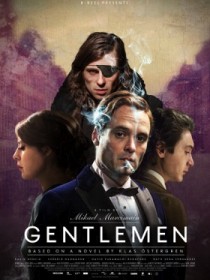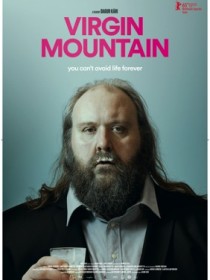


Karel, Paravel og Castaing-Taylor: Ah, Humanity!
Max Frisch skrev og udgav i 1979 en roman Mennesket dukker op i Holocæn og den mangetydige titel både dækker og resumerer i en kort sætning en fortælling om en gammel mand alene i sit hus i en lille landsby højt i Alperne med strømsvigt og afbrudte færdselsforbindelser på grund af meget regn og måske eller måske ikke truet af laviner og bjergskred. I en fremskridende tilstand af senilitet er den belæste og erfarne herre i gang med at repetere sin viden om menneskets forhold til naturen. Hans indprægningsevne svigter mere og mere så han skriver på sedler og klipper artikler ud af sit leksikon og monterer disse små papirer på vægge i huset for på den måde at konstruere en protese til sin beskadigede hjerne.
I Ah, Humanity! (Igen en titel som viser hen til Melville) er jeg blandt en senere tids, en senere teknologis, en senere æstetiks erindringssedler fra en senere tids encyklopædi, blandt dens mobiltelefonoptegnelser gennem en kikkert, dens filmcitater, dens lydoptagelser blandt andet af jordlagenes bevægelser klippet til en kort og massiv filmisk opera med et stort lyddesign som i biografen vil opleves som fire parallelle spor.
Jeg ser Lucien Castaing-Taylors, Verena Paravels og Ernst Karels film som et foregribende billede på en skildring (vel i begyndelsen af et uundgåeligt Postantropocæn) en skildring af ruiner efter det uddøde menneske. Fortumlet forsøger jeg et overblik: TIL STEDE / TOGET / BYGNINGERNE / MENNESKENE INDE I BYGNINGERNE / MENNESKENE MED HVIDE ÅNDEDRÆTSVÆRN… som var det overskrifter på små gule post its på væggen i klipperummet, kulturen opløst i huskesedler forsvindende i glemslens mørke barmhjertighed. Filmen vælger jeg at se som Ernst Karels og kollegernes tøvende og tvivlende og således ganske ærlige bidrag til en definiton af af CPH:DOX festivalens aktualisering af den siden 2000 (efter Paul J. Crutzens forslag) verserende alternative betegnelse Antropocæn for den nuværende geologiske periode. Det giver mig en del at tænke over og i hvert fald en konklusion: den film skal ses og genses og anbefales.
Japan, Frankrig, USA 2015, 23 min. Vises på CPH:DOX 2015.
SYNOPSIS
Det Harvard-baserede Sensory Ethnography Lab repræsenterer det mest avancerede, kontemporære krydsfelt imellem film og videnskabelig research. Véréna Paravel, Lucien Castaing-Taylor og Ernst Karels helt nye film- og lydværk ligger således i forlængelse af mastodontværket ‘Leviathan’ (New Vision Award, CPH:DOX 2012), som i den grad har sat et før og et efter i både filmens og forskningens verden. Ikke mindst i forsøget på at give den verden, der omgiver os og som vi selv har skabt, en filmisk form, der lader os se og erkende den på ny. Og denne gang er det Fukushima – optaget på en mobiltelefon og med et massivt lyddesign i fire parallalle spor. (CPH:DOX katalog)
“Ah, humanity! reflects on the fragility and folly of humanity in the age of the Anthropocene. Taking the 3/11/11 disaster of Fukushima as its point of departure, it evokes an apocalyptic vision of modernity, and our predilection for historical amnesia and futuristic flights of fancy. Shot on a telephone through a handheld telescope, at once close to and far from its subject, the audio composition combines excerpts from Japanese genbaku film soundtracks, audio recordings from scientific seismic laboratories, and location sound.” (New York Film Festival)
FILMOGRAFI
”Castaing-Taylor and Paravel are currently at work on various installations set in the middle of the Atlantic Ocean, as well forthcoming projects in Japan. Together with Ernst Karel, he and Paravel have recently completed Ah, humanity!, an installation about the anthropocene.” (Harvard Universitets hjemmeside). Leviathan, 2012.
CITAT
“Dead letters! does it not sound like dead men? Conceive a man by nature and misfortune prone to a pallid hopelessness, can any business seem more fitting to heighten it than that of continually handling these dead letters, and assorting them for the flames? Sometimes from out the folder paper the pale clerk takes a ring—the finger it was meant for, perhaps, moulders in the grave; a bank- note sent in swiftest charity—he whom it would relieve, nor eats nor hungers any more…on errands of life, these letters speed to death. Ah, Bartleby! Ah, humanity!” (Melville: “Bartleby the Scrivener”)
LINKS
http://cphdox.dk/program/film/?id=3015 (Katalogside, dansk)
http://cphdox.dk/en/programme/film/?id=3015 (Katalogue, English)
http://ves.fas.harvard.edu/people/lucien-castaing-taylor (Harvard University site)


